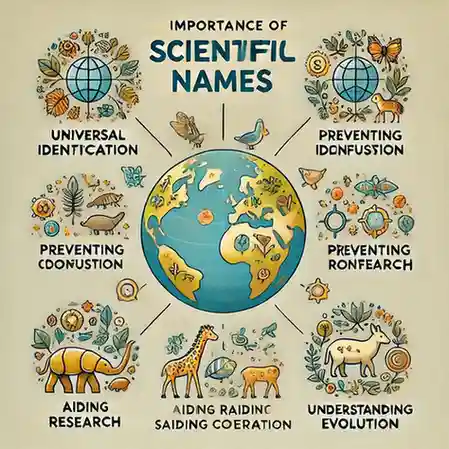How To Write Scientific Names Correctly Rules and Examples? Scientific names are written in binomial nomenclature, using Latin. The genus starts with a capital letter, and the species is lowercase, both italicized (e.g., Human scientific name is Homo sapiens).

Scientific names help in the classification and identification of organisms. Knowledge of the scientific names of organisms is essential for clear communication in the field of science. These names follow the rules as per the International Code of Nomenclature. This guide covers how to write a scientific name, its correct form, and the best examples so that the sun never sets on this knowledge in scientific societies around the world.
Table of Contents
The correct formatting of a scientific name is of utmost importance for research, classification, and academia. Many people have little insight into the actual way of writing scientific names, thus creating inconsistencies in the scientific literature. Thus, by learning the appropriate conventions, one will gain clarity and accuracy in biological studies and classification.
What is a Scientific Name?
A scientific name is a two-part Latin name assigned to every organism. This system, called binomial nomenclature, was first introduced by Carl Linnaeus. It consists of two essential components:
- Genus name: The first part of the name, is always capitalized.
- Species name: This is the second part of the name, always in lowercase.
For example:
- Homo sapiens (Humans)
- Felis catus (House cat)
- Canis lupus (Gray wolf)
Learning how to write the scientific name correctly helps to distinguish mistakes and confusion. Scientific names are known worldwide, unlike common names, which often differ from one tongue to the other and from one region to the next.
Rules for Writing Scientific Names
Here are a few prime rules for the proper writing of the scientific name:
1. Use Binomial Nomenclature
Every organism receives a name that consists of two parts: the genus name and the species name. This standard format is intended to provide a means of organizing and categorizing the species effectively.
For example:
- Tyrannosaurus rex (Dinosaur)
- Panthera leo (Lion)
2. Italicize or Underline the Scientific Name
Scientific names must be italicized when typed and underlined when written by hand.
For example:
- Correct: Homo sapiens (Italicized in print)
- Correct: Homo sapiens (Underlined in handwritten text)
- Incorrect: Homo Sapiens (Incorrect capitalization)
3. Abbreviate the Genus Name After First Mention
Genus name becomes abbreviated after the first use, while species name is changed.
For example:
- First mention: Escherichia coli
- Later mentions: E. coli
This abbreviation can lead to the reduction of redundancies but still keep the scientific name recognizable.
4. Capitalization Rules
In this case, the genus name is capitalized while the species name is lowercase.
For example:
- Correct: Canis familiaris (Dog)
- Incorrect: canis Familiaris
5. Subspecies and Varieties in Scientific Names
If any subspecies or varieties are present as grants, these follow after their species name.
For example:
- Panthera leo persica (Asiatic lion)
- Zea mays var. saccharata (Sweet corn)
6. Family and Higher Taxa Names
All taxonomic ranks above the genus, including family, order, or class, should be spelled in capital letters but should not be italicized.
For example:
- Family: Felidae (cats)
- Order: Carnivora (carnivores)
How to Correctly Write a Scientific Name in Different Contexts
Scientific names are written in different formats. This is how to correctly write a scientific name under various conditions:
For Research Papers
Always italicize and spell out the name the first time; thereafter, abbreviate the genus.
For example:
- The bacterium Escherichia coli is commonly found in the intestines. E. coli plays a crucial role in digestion.
In Books and Articles
In books and articles, scientific names should always be italicized.
For example:
- A study on the evolution of Panthera tigris populations.
In Labels and Handwritten Notes
When italics are unavailable, underline each part of the name independently.
For example:
- Homo sapiens (handwritten specimen label)

The Importance of Correctly Writing Scientific Names
Understanding how to write a scientific name correctly is beneficial to:
- Clear communication among scientists globally.
- Accurate species identification in research.
- Standardization across scientific disciplines.
Common Mistakes in Scientific Name Writing
These are common errors while learning how to write a scientific name correctly:
- Incorrect capitalization: Homo Sapiens (incorrect) vs. Homo sapiens (correct)
- Not italicizing: Homo sapiens (incorrect) vs. Homo sapiens (correct)
- Using the full genus name every time: Abbreviate it after first mention (E. coli instead of Escherichia coli).
Examples of scientific names in different categories
To practice how to write the scientific name correctly, here are some examples:
Mammals
- Homo sapiens – Human
- Felis catus – Domestic cat
- Canis lupus – Gray wolf
Birds
- Corvus corax – Common raven
- Struthio camelus – Ostrich
Plants
- Rosa indica – Indian rose
- Triticum aestivum – Wheat
Microorganisms
- Escherichia coli – Bacteria
- Saccharomyces cerevisiae – Yeast
Writing Scientific Names in Different Fields
1. In Medicine and Pharmacy
Medical personnel should know How to Write a Scientific Name Correctly when diseases and microorganisms are being discussed.
Example:
- Streptococcus pneumoniae causes pneumonia.
2. In Agriculture and Botany
Botanists follow special rules for varieties and subspecies of plants.
Example:
- Solanum tuberosum (Potato)
- Brassica oleracea var. botrytis (Cauliflower)
3. In Zoology and Wildlife Conservation
The wildlife researchers use How to Write a Scientific Name Correctly for documentation.
Example:
- Panthera pardus (Leopard)
Final thoughts On How To Write Scientific Names
Knowing the proper way to write scientific names is very important in biology, medicine, and research. By following proper rules, clarity and consistency in communication can be maintained in science. Using this proper format when writing academic papers, books, or research documents prevents errors. Knowing how to write the scientific name helps preciseness in taxonomy and classification.

